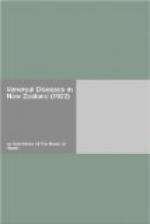Owing to the absence of accurate statistics it is impossible to make comparisons between New Zealand and other countries as regards the prevalence of venereal disease, or to say whether it is increasing or decreasing in this country.
There are in New Zealand no fewer than 3,031 persons being treated by registered medical practitioners for venereal disease in some form, or for the effects thereof—1 person in every 428 of our population. At the clinics since their establishment 3,634 patients have been treated—3,038 males, 596 females.
An interesting calculation as to the prevalence of syphilis in New Zealand has been made by Dr. Hay, Inspector-General of Mental Hospitals. Working on what is known as Fournier’s Index—the relation of the number of cases of dementia paralytica existing at any one time to the number of concurrent syphilitic infectious—he computes the number of persons in New Zealand now who have or have had syphilis to be 33,000, or 1 to every 38 of the population.
The Committee desire to state, however, that in their opinion there can be no accurate estimate of the prevalence of venereal disease until some system of obtaining accurate statistics has been adopted. One point which has come out clearly in their investigations is that venereal disease is sufficiently prevalent to cause serious concern and to call for energetic action.
Evidence was given to the Committee to show that children with mental and physical defects due to venereal diseases may become a charge on the State; that a proportion of these on being released become parents of defective children, who in their turn have to be supported at the public expense. It was also shown that such defectives have little sexual control, and are usually very prolific.
According to the Commissioner of Police there are only 104 professional prostitutes in New Zealand.
There is, however, a great deal of “amateur” prostitution, and this is chiefly responsible for the spread of venereal diseases.
The evidence points to a good deal of laxity of conduct among young people of all social conditions, especially in the large towns. This is generally attributed by the witnesses to the weakening of home influence and the restlessness of the age.
Apart from the venereal disease among those who indulge in promiscuous intercourse, there are many cases in which innocent wives are infected by their husbands, and other cases (not so frequent) of innocent husbands being infected by their wives.
Children suffer innocently from venereal disease, not only by inheritance from infected parents, but by accidently coming in contact with the germs on towels, &c., which have been used by a patient. There are also cases which come before the Courts where disease has been conveyed directly in crimes of violence by sexual perverts.
The free clinics in the chief centres are conducted by experts, and are doing good work. Their influence for good is greatly impaired, however, by the fact that a proportion of the male patients and the majority of the female patients leave off treatment before they are cured. As the law stands there is no power to compel them to continue treatment, and in many cases they resume promiscuous intercourse and spread the disease.




